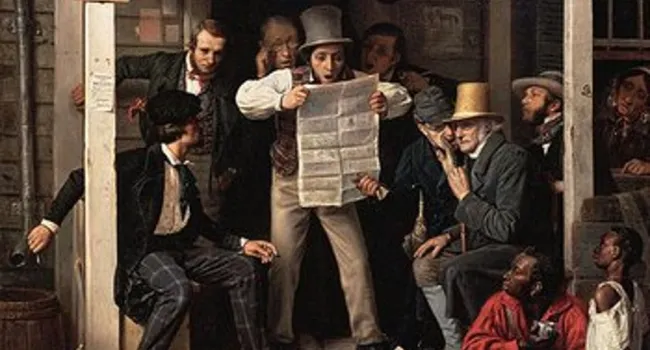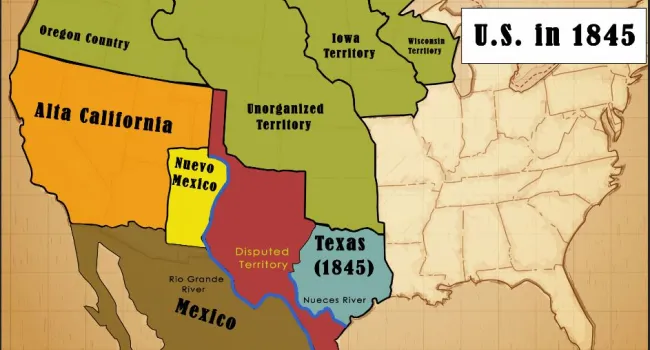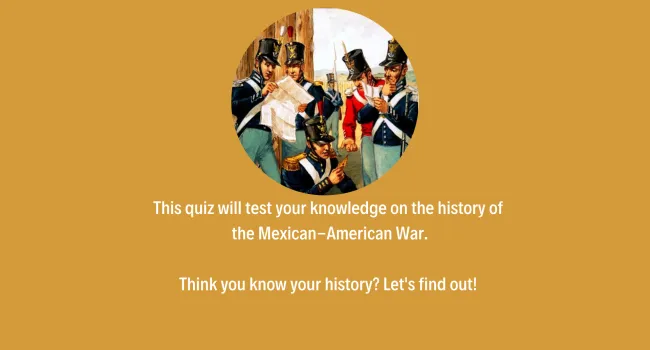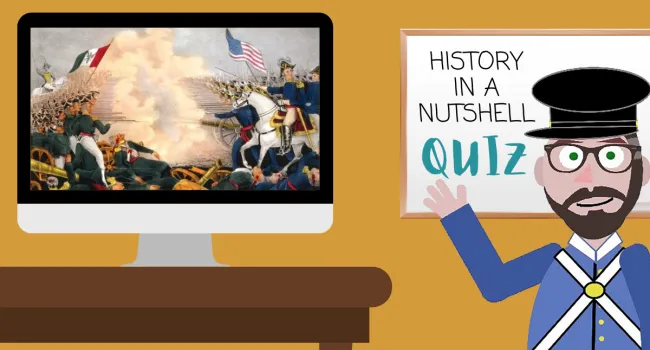Battle of Buena Vista: February 22-23, 1847. Also known as the Battle of La Angostura in Mexico, this is considered to be the bloodiest battle of the Mexican-American War. It was fought between U.S. forces under General Zachary Taylor, and the much larger Mexican Army under General Antonio López de Santa Anna. The outcome of the battle was ambiguous, with both sides claiming victory. Santa Anna was forced to withdraw his troops early to quell the political revolt in Mexico City.
Battle of Chapultepec: September 12-14, 1847. This was a battle between American forces under General Winfield Scott, and Mexican forces under command of General Antonio Lopez de Santa Anna. Mexican troops defended the strategically located Chapultepec Castle located just outside of Mexico City. The Mexicans' loss opened the way for the Americans to take the center of Mexico City.
Battle of Churubusco: August 20, 1847. While Santa Anna's army was in retreat from the Battle of Contreras or Battle of Padierna during the Mexican–American War. It was the battle where the San Patricio Battalion, made up largely of U.S. deserters, made their last stand against U.S. forces. The U.S. Army was victorious, outnumbering more than two-to-one the defending Mexican troops. After the battle, the U.S. Army was only 5 miles (8 km) away from Mexico City. 50 Saint Patrick's Battalion members were officially executed by the U.S. Army, all but two by hanging. Collectively, this was the largest mass execution in United States history.
Battle of Monterrey: September 21-24, 1846. During the Mexican–American War, General Pedro de Ampudia and the Mexican Army of the North was defeated by American forces under the command of General Zachary Taylor. The hard-fought urban combat led to heavy casualties on both sides. The battle ended with both sides negotiating a two-month armistice and the Mexican forces being allowed to peacefully withdraw in return for the surrender of the city.
Battle of Palo Alto: May 8, 1846. The Battle of Palo Alto was the first major battle of the Mexican-American War taking place in the disputed territory in Texas (present day city of Brownsville, Texas). 3,700 Mexican troops against 2,300 Americans led by General Zachary Taylor. On April 30, following the Thornton Affair, Mexican General Mariano Arista's troops began to cross the Rio Grande. On May 3, the troops began to besiege the American outpost at Fort Texas. Taylor marched his Army of Occupation south to relieve the siege. Arista, upon learning of his approach, diverted many of his units away from the siege to meet Taylor's force. Arista ordered two cavalry charges, first against the American right flank and later against the left. Both were unsuccessful. The American victory is widely attributed to superior artillery, as the U.S. "light" artillery was much more mobile and accurate than that of the Mexican forces. That evening, Arista was forced to withdraw further south. The armies clashed again the next day at the Battle of Resaca de la Palma.
Battle of Resaca de la Palma: May 9, 1846. Taking place the following day after the Battle of Palo Alto, American forces under General Zachary Taylor engaged the retreating Mexican forces under command of General Mariano Arista. The U.S. victory resulted in Mexican forces being forced out of Texas.
Brigadier General Stephen W. Kearny: He is remembered for his significant contributions in the Mexican–American War, especially the conquests of Nuevo Mexico and of Alta California. The Kearny code, proclaimed on September 22, 1846, in Santa Fe, established the law and government of the newly acquired territory of New Mexico and was named after him.
Flying Artillery: A term used to describe the strategy of using cannons that were pulled by teams of horses in order to increase their mobility and effectiveness. This was a new strategy in the context of the American army, and was used to devastating effect in battle.
General Antonio Lopez de Santa Anna: Commanding general of Mexican forces during the Mexican American War. An enigmatic, patriotic, and controversial figure, López de Santa Anna wielded great power and influence in Mexico during the turbulent 40 years of his political career. He led as general at crucial points and served multiple non-consecutive presidential terms over a period of 22 years. In the periods when he was not serving as president, he continued to pursue his military career. He was a wealthy landowner who built a political base in the port city of Veracruz. Perceived as a hero by his troops, López de Santa Anna sought glory for himself and for his army and independence for Mexico. He repeatedly rebuilt his reputation after major losses. Yet historians and many Mexicans rank him as one of "those who failed the nation".
President Mariano Paredes: President of Mexico at the outbreak of the Mexican-American War. Before the conflict started, Paredes had expressed interest in establishing a monarchy in Mexico before abandoning the idea to focus on the war. Due to a series of military losses, Paredes faced the prospect of being overthrown and resigned on 28 July 1846.
General Pedro de Ampudia: Mexican general in charge of the defenses at the city of Monterrey. After a skilled defense of the city at the Battle of Monterrey, Ampudia found American forces entered from the west and east. Trapped in the city plaza and bombarded by U.S. forces with howitzers, General Ampudia chose to request a flag of truce and retreat his battered army. His arrangement with Zachary Taylor allowed the Army of the North to keep its weapons but march as far south as possible and neglect offensive operations for three months.
General Winfield Scott: Nicknamed “Old Fuss and Feathers”, Scott served as a general in the United States Army from 1814 to 1861, taking part in the War of 1812, the Mexican–American War, the early stages of the American Civil War and conflicts with Native Americans. In 1841, Scott became the Commanding General of the United States Army, beating out his rival Edmund P. Gaines for the position. After the outbreak of the Mexican–American War in 1846, Scott was relegated to an administrative role, but in 1847 he led a campaign against the Mexican capital of Mexico City. After capturing the port city of Veracruz, he defeated Mexican General Antonio López de Santa Anna's armies at the Battles of Cerro Gordo, Contreras, and Churubusco. He then captured Mexico City, after which he maintained order in the Mexican capital and indirectly helped envoy Nicholas Trist negotiate the Treaty of Guadalupe Hidalgo, which brought an end to the war.
General Zachary Taylor: Nicknamed "Old Rough and Ready." During the Mexican-American War, Taylor was a career officer in the U.S. Army, rising to the rank of Major General and become a national hero as a result of his victories in the Mexican-American War. In 1845, during the annexation of Texas, President James K. Polk dispatched Taylor to the Rio Grande in anticipation of a battle with Mexico over the disputed Texas–Mexico border. The Mexican–American War broke out in April 1846, and Taylor defeated Mexican troops commanded by General Mariano Arista at the battles of Palo Alto and Resaca de la Palma, driving Arista's troops out of Texas. Taylor then led his troops into Mexico, where they defeated Mexican troops commanded by Pedro de Ampudia at the Battle of Monterrey. Defying orders, Taylor led his troops further south and, despite being severely outnumbered, dealt a crushing blow to Mexican forces under General Antonio López de Santa Anna at the Battle of Buena Vista. Taylor's troops were subsequently transferred to the command of Major General Winfield Scott, but Taylor retained his popularity.
José Manuel de la Peña y Peña: A Mexican lawyer and judge who served two non-consecutive, but closely following terms as the president of Mexico during the Mexican American War. In contrast to many other nineteenth century Mexican presidents, he never served in the military, instead coming from a distinguished legal background. He served as interim president of Mexico when the time came to negotiate the Treaty of Guadalupe Hidalgo.
Los Niños Héroes: In Mexican history, the Battle of Chapultepec is cast as the story of the brave deaths of six cadets, the Niños Héroes, who leapt to their deaths rather than be taken captive, with one wrapping himself in the Mexican flag.
Manifest Destiny: The idea that the United States is destined—by God, its advocates believed—to expand its dominion and spread democracy and capitalism across the entire North American continent.
Nicholas Trist: Even though he was dismissed by President James K. Polk as the negotiator with the Mexican government, he negotiated the Treaty of Guadalupe Hidalgo in 1848, which ended the Mexican-American War. The U.S. conquered Mexican territory and vastly expanded the United States.
President James K. Polk: The 11th President of the U.S. Polk was elected in 1844 and served from 1845-1849. Polk is most well-known for extending the territory of the United States through the Mexican-American War – gaining Mexico’s northern territories. He was a proponent of Manifest Destiny.
San Patricios: Also known as the St. Patrick’s Battalion, it was a unit of 175 to several hundred (accounts vary) immigrants and expatriates of European descent who fought as part of the Mexican Army against the United States in the Mexican–American War of 1846–48. Formed and led by John Riley, the battalion's members included many who had deserted or defected from the United States Army. The battalion served as an artillery unit for much of the war. Despite later being formally designated as two infantry companies, it retained artillery pieces throughout the conflict. The San Patricios were responsible for the toughest battles encountered by the United States in its invasion of Mexico, with Ulysses S. Grant remarking that "Churubusco proved to be about the severest battle fought in the valley of Mexico". Composed primarily of Catholic Irish immigrants, the battalion also included Germans, Canadians, English, French, Italians, Poles, Scots, Spaniards, Swiss, and Mexicans, most of whom were Catholics. Disenfranchised Americans were in the ranks, including escaped slaves from the Southern United States.
Siege of Veracruz: March 9-29, 1847. The Battle of Veracruz was a 20-day siege of the key Mexican beachhead seaport of Veracruz during the Mexican–American War. Lasting from March 9–29, 1847, it began with the first large-scale amphibious assault conducted by United States military forces, and ended with the surrender and occupation of the city. U.S. forces then marched inland to Mexico City.
The Thornton Affair: April 25, 1846. Also known as the Thornton Skirmish, it was a battle in 1846 between the military forces of the United States and Mexico 20 miles (32 km) west upriver from Zachary Taylor's camp along the Rio Grande. The much larger Mexican force defeated the American cavalry troop under command of Captain Seth Thornton in the opening of hostilities, and was the primary justification for U.S. President James K. Polk's call to Congress to declare war on May 13, 1846.
Treaty of Guadalupe Hidalgo: The peace treaty that was signed on 2 February 1848, in the Villa de Guadalupe Hidalgo (now a neighborhood of Mexico City) between the United States and Mexico that ended the Mexican–American War (1846–1848). The treaty was ratified by the United States on 10 March and by Mexico on 19 May. Its provisions called for Mexico to cede 55% of its territory (present-day Arizona, California, New Mexico, and parts of Colorado, Nevada and Utah) in exchange for fifteen million dollars in compensation for war-related damage to Mexican property. Other provisions stipulated the Texas border at the Rio Grande (Article V), protection for the property and civil rights of Mexican nationals living within the new border (Articles VIII and IX), U.S. promise to police its side of the border (Article XI), and compulsory arbitration of future disputes between the two countries (Article XXI). When the U.S. Senate ratified the treaty in March, it reduced Article IX and deleted Article X guaranteeing the protection of Mexican land grants. Following the Senate's ratification of the treaty, U.S. troops left Mexico City.




